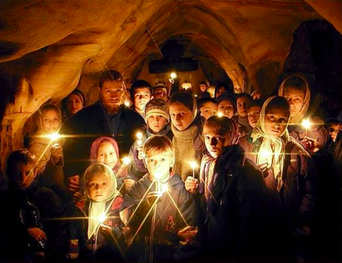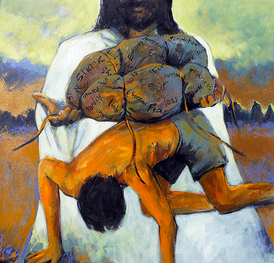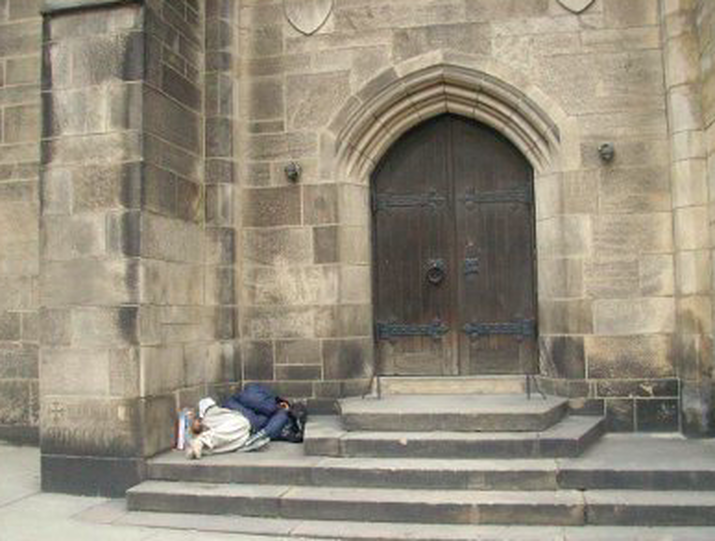 Some quotes of importance from my reading this morning. As we approach Easter, we reminisce the empty tomb, and rightly so, but we should also reimagine that the local church is the reality of the resurrection . . . the gathered church in a local place, in the flesh of the community, are sites of the resurrection presence of Jesus in the here and now. Yet, the way in which a church demonstrates the power of the resurrection is by living out a cruciformed (cross-oriented) life among its congregation and in the midst of the community that surrounds it. The quotes: “. . . these [church] communities gathered as sites of resurrection presence.” “Resurrection presence can only be enjoyed and inhabited by grace through cruciform postures of self-giving love, service, and celebration.” “. . . resurrection presence is encountered wherever people gather in the name of Jesus and adopt a cruciform identity.” “It is no less countercultural in our day where a variety of pressures force churches to attract increasing numbers of people by appealing to cultural desires that are subtly shaped by the present evil age . . . The redeeming presence of heaven is brought to earth in cruciform communities, transforming our imaginations so that we see the world as God sees it. It is not a world of limited goods where we all must hoard and protect our stuff and pursue our own selfish desires.” “Churches enjoy the superabundant realities of heaven by enacting cross-oriented community behaviors that we find throughout the Gospels and Paul’s letters: confession of sin and forgiveness, service to one another, self-giving love embodied through meeting one another’s needs and offering hospitality to one another—especially to those on the margins of our communities.” ~Timothy Gombis, Power in Weakness: Paul's Transformed Vision for Ministry (p. 52–54)
0 Comments
IV. Our Church Life should be an Invitation to Come to Jesus, take His Yoke, and You will Find Rest: We are to embody the invitation to Come Our little Hill church puts itself into the heart of the community: at the Hill North Community Management Team, the Free Sidewalk Breakfast each Saturday, our Summer Park BBQ ministry; showing up to almost every community event, and my pastoral street counseling right out my front door. When John the Baptist was facing the end of his ministry (in Matthew 11), he told his own disciples to go ask Jesus if he was the One or should they look for another (was this for John or his disciples, I have my opinion on that, but it is surely for the church). How do they know Jesus is the One and there is none other to look for? Jesus asks them what they see (which implies action, demonstration, something happening): How do they know? ➥ the blind receive sight ➥ the lame walk ➥ lepers are cleansed ➥ the deaf hear ➥ the dead are raised up ➥ the poor have the gospel preached to them (Matthew 11:4-6) This is exactly what Jesus has been doing as his disciples followed him around. No doubt this is Matthew’s version of Luke’s draw on Isaiah 61, which promises that God’s Spirit would be on the Messiah to preach the gospel to the poor, to heal, to free and bring justice (Isaiah 61:1). This is the context in Matthew. This is exactly what Jesus is doing. This is what the temple and synagogue leadership miss, ignore, or are fighting against.They are still bothered for in Matthew 11:19 there is more accusation: . . . they say, ‘Look at him! A glutton and a drunkard, a friend of tax collectors and sinners!’ We end our thread in Matthew 11 where Jesus invites all who labor and are heavy laden to come. First, Jesus praises the Father that “all things have been handed over” to Him “and no one knows the Son except the Father, and no one knows the Father except the Son and anyone to whom the Son chooses to reveal him.” As Presbyterians, we identify with this divine election. Yet we forget that the means of grace to call the elect is given at the same time: 28Come to me, all who labor and are heavy laden, and I will give you rest. 29Take my yoke upon you, and learn from me, for I am gentle and lowly in heart, and you will find rest for your souls. 30 For my yoke is easy, and my burden is light.” Recently during a Hill Sunday sermon on Matthew 11, I asked my own congregation: “How do you think the young church, with nothing much to offer, no social or political power, possessing little resources—and life didn’t really get easier and better for early believers. They risked everything, and for most, life got harder. In the first 150 years after Pentecost, how did Christianity became the largest religious sect in and around the Roman Empire? How? They accepted all into their fellowship, this changed their households . . . street by street, village by village, table by table. It all changed where gathered-churches lived out “Come all who labor and are heavy laden.” The body of Christ, the local church, with Jesus our Head, ruling and reigning at the Father’s right hand, is His presence in the community, in the Hill community, in your community right here in Concord. We show them Jesus by who we are and what we do so that all who struggle and toil and are carrying burdens no one should carry alone (because they see) hear the invitation to Come to Jesus and take on His yoke and find rest. We are to embody the invitation to Come. We need to be refreshed in the gospel every time we gather because we need the power of the gospel in order to be the gospel in action. I might get everything else wrong about church planting . . . I might not even be very good at it, at least not good at what is expected . . . but one thing I will get right, by God’s grace, to help the CPC in The Hill flock understand and know what it means to follow Jesus around . . . Our church does this . . . even though we are a church in an under-resourced community, we spend ourselves on our community, attempting to associate with the lowly, the hurt, those who's lives are messing, unclean, spoiled, and forgotten. A church needs to be where crowds are (out in the ebb and flow of community life): this is why our small under-resourced church spends its time in the community, places where crowds show up. This is what it means to follow Jesus around and it is how others know that the kingdom of heaven has appeared. *This sermon was preached at Redeemer Presbyterian Church in Concord, MA on Sunday, May 19, 2019. The full sermon maybe downloaded as a PDF (here). An audio version is also be available >> Audio version Part I | Part II | Part III | Part IV
Recently during a Sunday sermon on Matthew 11, I asked: “How do you think the young church, with nothing much to offer, no social or political power, possessing little resources—and life didn’t really get easier and better for early believers. They risked everything, and for most, life got harder. How do you think, in the first 150 years after Pentecost, Christianity became the largest religious sect in and around the Empire? How? “They changed their households . . . street by street, village by village, at the table [I pointed to our table where we would shortly celebrate the Lord’s Supper together]. It all changed right here where gathered-churches lived out ‘Come all who labor and are heavy laden.’ “The body of Christ, the local church, with Jesus our Head, ruling and reigning at the Father’s right hand, is His presence in its community. We show them Jesus by who we are and what we do so that all who struggle and toil and are carrying burdens no one should carry alone hear (because they see) the invitation to Come to Jesus and take on His yoke and find rest. We are to embody the invitation to Come.” ¿Como piensas que la iglesia naciente sin nada que ofrecer, sin poder, careciendo de recursos? - y la situación no se puso ni mas fácil ni mejor para estos primeros creyentes que se arriesgaron todo, sino la vida mayormente se les hizo aún más difícil - ¿Como piensas que dentro de 150 años el cristianismo llegó a ser la religión más prominente en y alrededor del imperio Romano?
¿Cómo? Ellos hicieron cambiar sus hogares ... calle por calle, aldea por aldea, en la mesa. Todo se cambió allí mero, donde las iglesia reunida practicaba el "Venid a mí, todos los que estáis cansados y cargados." El cuerpo de Cristo es la iglesia local, con Jesús como nuestra cabeza regiendo y reinando a la diestra del Padre, su presencia en esa comunidad. Les demostramos a Jesús por quienes somos y por lo que hacemos para que todo aquel que lucha y labora y que lleva carga pesada no lo haga a solas porque oye y ve la invitación de venir a Jesús y tomar su yugo y hallar descanso. Debemos encarnar la invitación a venir.  Church leaders should, at least, question who benefits and who does not benefit from current church structures and bureaucracies (i.e., church life and function). The building-centered and business-centric models that most contemporary church-systems emulate can result in duplicitous habits, which can be suggestive of a protective posture for its leaders and for the cultural status quo. Our ways of doing church are not neutral. The temple system into which the gospel is introduced in the New Testament, as well as its leadership, were antithetical to the arrival of the kingdom that had been inaugurated by Jesus’ arrival. Perhaps it is not the construction of temples or the development of religious bureaucracies per se, but the energy and resources used to maintain these systems that promote the status of their own authorities and stakeholders, which can distract (to put it blandly) from a church’s responsibility toward the poor. Rather than laboring to maintain current church systems and structures, contemporary church leaders need to promote the church’s responsibilities to the poor. Otherwise, they may replicate the social and cultural location described throughout the Gospels and the Acts of the Apostles. The cost of doing church business and maintaining church bureaucracies are not neutral to the church’s role as advocates for the poor. This includes the allocation of human, financial, and social capital available in and through a church or a consortium of churches for use in the public square. Such allocations of financial and human capital could be used for advocating and caring for the economically vulnerable and the poor. The resources and capacity of the local church need to be evaluated, not by our contemporary cultural expressions of church life, but in terms of the kingdom of God, which certainly includes addressing the causes of poverty and advocating for the poor. Andrew Davey, in his book Urban Christianity and Global Order, insists that a church concerned about “its own sustainability must have strategies other than the growth paradigm” (p. 112). Contemporary church growth models are multimillion-dollar business ventures with huge marketing campaigns and an elite celebrity leadership of its own that promote costly expectations for a local church. There should be consideration whether such growth expectations divert resources and human capital away from a church’s responsibilities regarding the poor. While a church’s sustainability should be directed outward and toward the future, it should also have positive, redemptive consequences for the community, with special consideration for its vulnerable populations. Adapted from chapter 1 of Wasted Evangelism, "Widows in Our Courts (Mark 12:38–44): The Public Advocacy Role of Local Congregations as Discipleship."
|
AuthorChip M. Anderson, advocate for biblical social action; pastor of an urban church plant in the Hill neighborhood of New Haven, CT; husband, father, author, former Greek & NT professor; and, 19 years involved with social action. Archives
February 2024
Categories
All
|
Pages |
More Pages |
|

 RSS Feed
RSS Feed